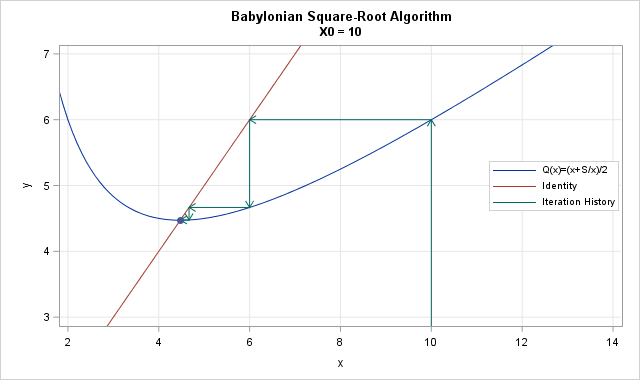I was eleven years old when I first saw Newton's method.
No, I didn't go to a school for geniuses. I didn't even know it was Newton's method until decades later. However, in sixth grade I learned an iterative algorithm that taught me (almost) everything I need to know about Newton's method for finding the roots of functions.
Newton's method and an iterative square root algorithm
The algorithm I learned in the sixth grade is an iterative procedure for computing square roots by hand. It seems like magic because it estimates a square root from an arbitrary guess. Given a positive number S, you can guess any positive number x0 and then apply the "magic formula" xn+1 = (xn + S / xn)/2 until the iterates converge to the square root of S. For details, see my article about the Babylonian algorithm.
It turns out that this Babylonian square-root algorithm is a special case of Newton's general method for finding the roots of functions. To see this, define the function f(x) = x2 - S. Notice that the square root of S is the positive root of f. Newton's method says that you can find roots by forming the function Q(x) = x - f(x) / f′(x), where f′ is the derivative of f, which is 2x. With a little bit of algebra, you can show that Q(x) = (x + S / x)/2, which is exactly the "magic formula" in the Babylonian algorithm.
Therefore, the square root algorithm is exactly Newton's method applied to a special quadratic polynomial whose root is the square root of S. The Newton iteration process is visualized by the following graph (click to enlarge), which shows the iteration history of the initial guess 10 when S = 20.

Everything I need to know about Newton's method...
It turns out that almost everything I need to know about Newton's method, I learned in sixth grade. The Babylonian method for square roots provides practical tips about how to use Newton's method for finding roots:
- You need to make an initial guess.
- If you make a good initial guess, the iteration process is shorter.
- When you get close to a solution, the number of correct digits doubles for each iteration. This is quadratic convergence in action!
- Avoid inputs where the function is not defined. For the Babylonian method, you can't plug in x=0. In Newton's method, you need to avoid inputs where the derivative is close to zero.
- Different initial guesses might iterate to different roots. In the square root algorithm, a negative initial guess converges to the negative square root.
In fact, I'll go further. The Babylonian method teaches important lessons in numerical analysis:
- Root-finding is a fundamental tool that helps you solve all kinds of numerical problems.
- Many problems that do not have exact answers can be solved with iterative methods.
- Iterative methods often linearize the problem and use the linear formulation as part of the algorithm.
So you see, all I really needed to know about Newton's method I learned in sixth grade!

3 Comments
So, Q_N(x) for Nth roots is [ x*(N-1) + S/x^(N-1) ]/N. And N does not have to be an integer, or even > 1. N > 0 is recommended, though.
After playing with it, it's really slow for higher roots and bad x_0 guesses. A replacement for **, this is not. :-)
Yes, as the power gets higher, the function x**n - S is really really flat on [0,1] and really really steep for x greater than 2. Therefore an initial guess less than 1 shoots out and results in a next guess that is very large. (As it says in the fourth bullet, "avoid inputs where the derivative is close to zero.") When x is large, the function is so steep that it takes many iterations to march back towards the root.
On the other hand, one you get close to the root, Newton's method will converge REALLY fast! So use a bounding method to search for an initial guess and then use two or three iterates of Newton's method to home in on the accuracy.
Pingback: Compute the square root matrix - The DO Loop